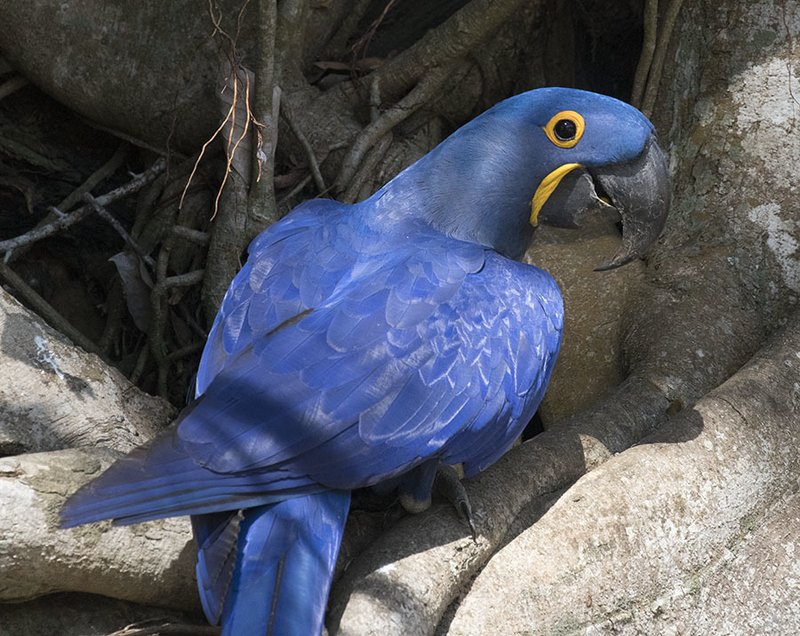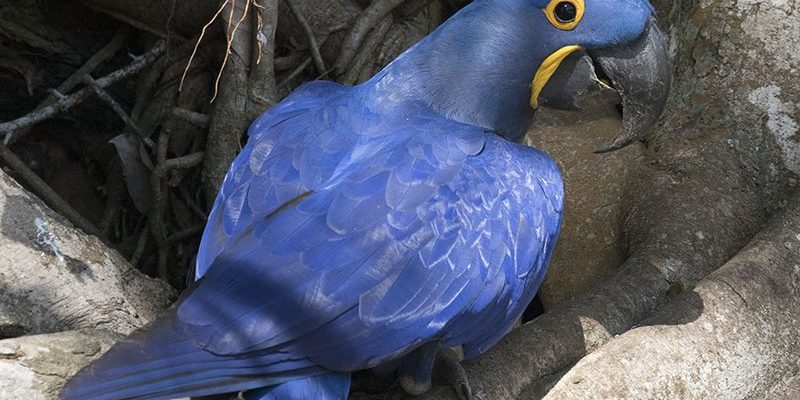
In this journey through time, we’ll explore the origins, habits, and conservation status of the Hyacinth Macaw. So grab your cup of coffee, get comfortable, and let’s dive into the fascinating evolution of this magnificent bird!
Origins of the Hyacinth Macaw
The Hyacinth Macaw (Anodorhynchus hyacinthinus) hails from South America, particularly the Brazilian rainforest, where it roams the canopy in search of food. These parrots thrive in open forests, woodland areas, and even savannas. Their natural habitat offers them a rich diet primarily consisting of nuts, seeds, and fruits, particularly from palm trees.
What’s really interesting is that these macaws are the largest flying parrots in the world. They can reach lengths of over 3 feet, which is quite a sight to behold! They have a powerful beak, which acts like nature’s own nutcracker, allowing them to crack open hard seeds. This impressive beak isn’t just for food; it plays a vital role in climbing and social interactions, making it a key feature of their evolution.
You might be wondering how they evolved to thrive in such diverse environments. Over millions of years, the Hyacinth Macaw adapted not just physically—growing stronger beaks and larger bodies—but also behaviorally, developing social structures that help them survive in the wild.
The Early History and Discovery
While the Hyacinth Macaw has existed for thousands of years, it wasn’t until the late 18th century that Europeans began to take notice of these striking birds. As explorers and naturalists ventured into the Brazilian jungle, they documented their findings, bringing these magnificent creatures back to the attention of the world.
Early descriptions of the Hyacinth Macaw painted a picture of a majestic bird unlike any other. But the truth is, their beauty put them at risk. The growing fascination with exotic pets led to an increase in capture and trade, which was detrimental to their populations.
By the mid-20th century, the Hyacinth Macaw was facing serious threats from habitat loss and illegal trapping. Conservationists recognized the bird’s plight, and efforts to protect them began to gain momentum. It was a pivotal moment in the history of the Hyacinth Macaw, marking the start of serious conservation efforts aimed at ensuring their survival.
Conservation Efforts: A Modern Rescue
In response to the decline of the Hyacinth Macaw population, dedicated conservation groups have worked tirelessly to protect these remarkable birds. Their efforts encompass habitat restoration, legal protections, and public awareness campaigns. Let’s break down some of these initiatives:
- Habitat Restoration: Many organizations have focused on reforesting areas where these macaws used to thrive. By planting native trees and restoring their natural habitat, they can support the delicate ecosystem that these birds rely on.
- Legal Protections: In various countries, laws have been established to prohibit the capture and trade of Hyacinth Macaws. These laws are crucial in preventing illegal trafficking and ensuring the survival of the species.
- Public Awareness: Educating the public about the plight of the Hyacinth Macaw is essential. Many organizations run campaigns to raise awareness about their conservation status, helping people appreciate the importance of protecting these beautiful birds.
Thanks to these combined efforts, the population of Hyacinth Macaws is slowly recovering. Their situation serves as a reminder of how proactive approaches can lead to positive change in the animal kingdom.
Unique Behaviors and Social Structure
Hyacinth Macaws are known for their complex social behavior. You’ll often find them in pairs or small flocks, demonstrating strong pair bonds that can last a lifetime. These bonds are not just about companionship; they also play a crucial role in their survival and reproduction.
Interestingly, the Hyacinth Macaw is quite vocal. They communicate through a variety of sounds, from gentle coos to loud squawks, making it easy to identify their presence in the wild. Social interactions are common, and you might catch them engaging in playful antics, such as chasing one another or playing with branches.
Breeding typically occurs during the rainy season, with pairs working together to find suitable nesting sites in tree cavities. Here, they lay one to three eggs, which both parents incubate. Once the chicks hatch, both parents are involved in feeding and caring for their young. This level of parental care is quite remarkable and highlights their strong family bonds.
The Hyacinth Macaw in Captivity
Due to their beauty and intelligence, Hyacinth Macaws have become popular in aviculture. However, keeping one as a pet comes with responsibilities and challenges. These birds require a lot of space, social interaction, and mental stimulation.
Many experts argue that keeping them in captivity can lead to health and behavioral issues if not done properly. They’re highly social creatures that thrive on interaction and need plenty of toys and activities to keep them occupied. For those who want a companion, it’s essential to be prepared for the commitment that comes with caring for a Hyacinth Macaw.
On the positive side, many breeders and sanctuaries work to educate prospective owners about the needs of these remarkable birds and promote ethical breeding practices. This helps ensure that future generations of Hyacinth Macaws can thrive, both in captivity and in the wild.
Threats to Survival and Future Outlook
Despite improvements in their conservation status, the Hyacinth Macaw still faces threats that could jeopardize their future. Habitat destruction, primarily due to logging and agriculture, continues to be a significant issue. These activities not only reduce the area where they can live but also affect the food sources they rely on.
Additionally, illegal trapping still occurs. While laws exist to protect them, enforcement is often lacking in remote areas. Conservation organizations continue to work hard to combat these issues through increased patrols and community engagement.
Looking ahead, the future of the Hyacinth Macaw depends on continued conservation efforts and public support. By making small changes in our daily lives, like advocating for sustainable practices and supporting wildlife organizations, we can all contribute to protecting these incredible birds.
The story of the Hyacinth Macaw is not just about a beautiful bird; it’s a tale of resilience, conservation, and the enduring bond between humans and nature. As we reflect on their history, it’s clear that protecting their habitat and ensuring their survival is a shared responsibility.
With ongoing conservation efforts and a commitment to respecting their natural environment, there’s hope for the future of the Hyacinth Macaw. By staying informed and engaged, we can help preserve this natural treasure for generations to come. So, the next time you see a picture of these magnificent birds, remember their journey and the importance of protecting biodiversity around the world.

